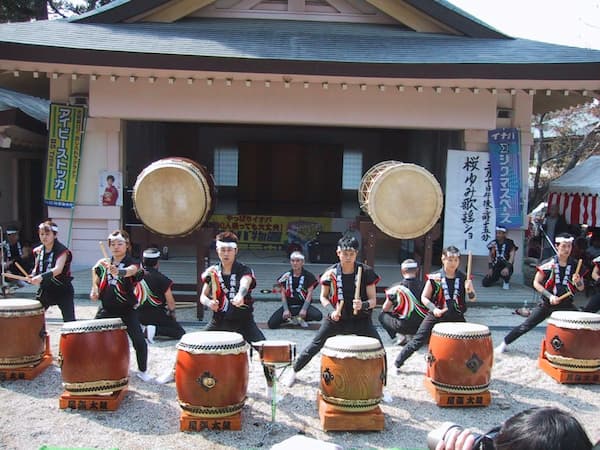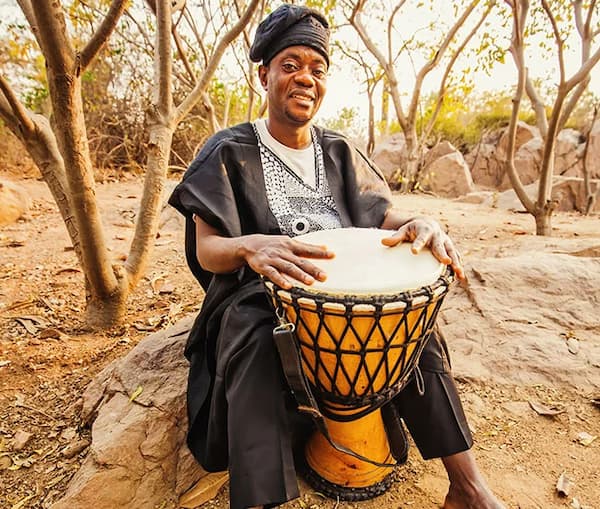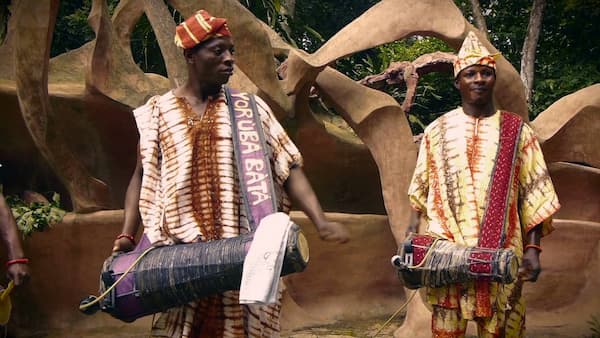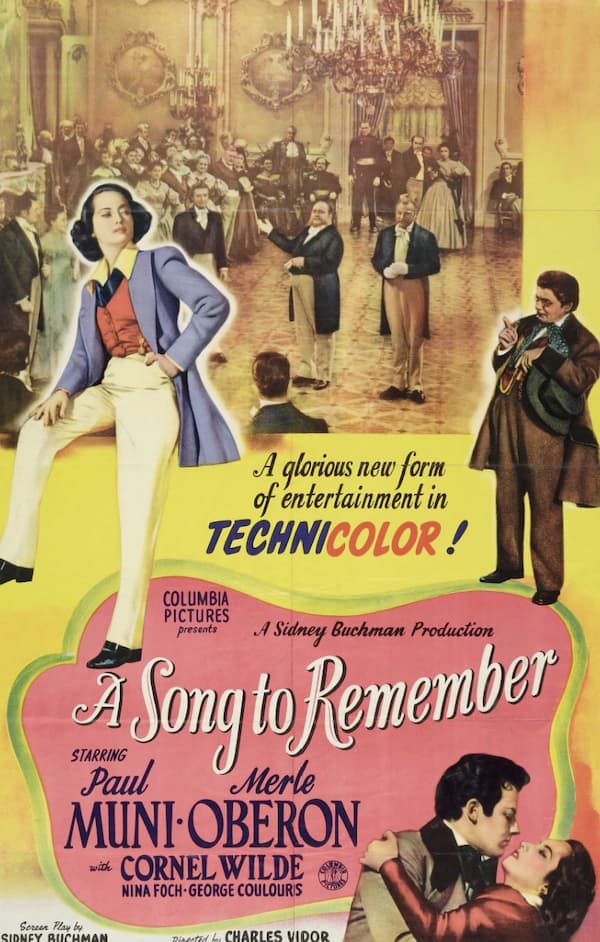Drums are among the oldest and most universal instruments. They resonate across cultures, weaving rhythm into the fabric of human society.
They serve as tools for communication, celebration, and establishing spiritual connections. Drums mark life’s milestones, from births to funerals, and they unite people in dancing and storytelling.
Drums signal war and herald peace as they embody a primal energy that shapes cultural identity and collective experiences.
Won’t you join me for a trip around the world that explores various drums and their unique sound and cultural significance in different societies?
Taiko (Japan)

Taiko drummers in Aichi, Japan
Let’s get started with Japan’s thunderous percussion art called Taiko drumming. It is as much a physical spectacle as it is a musical one. Rooted in ancient Shinto rituals, festivals, and battlefield communication, the word “taiko” just means drum, but it refers to a range of barrel-shaped instruments.
Drummers don’t just play but perform with choreographed full-body strikes that look like a martial arts dance. The sticks are called “bachi,” and the rhythms are primal yet intricate, often mimicking the natural sound of rolling thunder or crashing waves.
Taiko drumming blends precision rhythms with acrobatic flair, and some people believe that the drum actually holds a spirit. As such, they retire old drums with ceremonies, treating them like living things.
Kodo: Taiko drumming
Tabla (India)

Set of tabla drums with tabla hammer
The tabla is a pair of hand-played drums; the smaller dayan (right drum) is tuned to a specific pitch, while the larger bayan (right drum) delivers deeper and bass-heavy tones. Tabla emerged in the 18th century and was tied to Hindustani music, having evolved from older drums.
The instruments are made from wood, metal, and animal hide, and they are played with a dizzying mix of finger taps, palm slaps, and slides that create intricate rhythms and textures. Tabla drumming is considered the cornerstone of Indian classical music.
The tabla speaks an intricate and expressive rhythmic language through a specific vocabulary called “bols.” These different syllables are woven into complex patterns called “tala” and loop with a hypnotic groove. Blending precision with improvisation, the tabla is not only an instrument but a storyteller, integral to cultural and spiritual expression.
Tabla Performance
Djembe (West Africa)

Djembe musician in Africa
The goblet-shaped drum called “djembe” is widely recognised in West Africa, particularly among the Mandinka people of Mali, Guinea, Senegal, and Côte d’Ivoire. Traditionally carved from a single piece of wood and topped with goatskin, it produces a versatile sound.
The instrument can produce deep bass notes, resonant tones, and sharp, high-pitched slaps, that make it a cornerstone of communal life. Djembe drumming accompanies rites of passage, such as births, initiations, weddings, and funerals, serving as a sonic bridge between the physical and spiritual worlds.
Specific rhythms carry distinct meanings, reinforcing community bond as the name of the instrument means “everyone gather together in peace.” It is often used in storytelling, with rhythms encoding oral histories or social values that are passed down through generations by special historians and musicians.
Jalikunda: Djembe drumming
Kendang (Indonesia)

Kendang
The double-headed drum called “kendang” is integral to Indonesian music. Typically made of wood with adjustable drumheads, its pitch can be modified by tightening or loosening the ropes.
The instrument is part of the cultural fabric of Java and Bali, and in gamelan ensembles it acts as the rhythmic leader, dictating tempo and cuing transitions in performances of court dances and temple ceremonies. The kendang embodies spiritual and artistic harmony.
Played with hands or mallets, it carries sacred weight in communities across diverse Indonesian contexts, sounding during rituals and dances while symbolising vitality and divine connection. In different contexts, its playful rhythms reflect social energy and communal joy.
Kendang drumming
Darbuka (Middle East/North Africa)
The single-headed percussion instrument widely used across the Middle East and North Africa is called the “darbuka,” or goblet drum. Its distinctive shape, with a narrow base and wider head, gives it a versatile range of tones.
The instrument is traditionally made from clay or metal with a stretched animal skin or synthetic head, and its expressive tone qualities make it a staple in various musical traditions. The darbuka rhythms carry historical and emotional weight, preserving oral traditions and regional identities.
Depending on geographical region, darbuka drives middle-eastern classical music, belly dancing and pop. It is a key to Romani and folk music across the Balkans, and the heartbeat of weddings and religious festivals. It signals joy, trance, or spiritual devotion in Sufi ceremonies, and it is inseparable from belly dancing, where drummers improvise to match the dancer’s movements, creating a dynamic dialogue.
Darbuka performance with Belly Dance
Batá (Nigeria/Cuba)

Batá drummer
Batá drumming is rooted in Yoruba culture from Nigeria and widely practised in Cuba, Puerto Rico, and beyond. It is a powerful musical tradition with a deep social significance used primarily in religious ceremonies.
It is played on a set of three double-headed and hourglass-shaped drums. Each drum varies in size and pitch, and thus it enables complex and interlocking rhythms. It communicates spiritual and communal practice and shapes social bonds and cultural identities across various contexts.
Batá drumming unites communities, but its social role isn’t without conflict. The exclusion of women from sacred drumming, rooted in religious taboos, highlights a gender inequality. As colloquial lyrics replace poetic ones in non-religious settings, original meanings become diluted. However, its adaptability also ensures relevance and makes it a profound link between past, present, and future.
Batá drumming
Zarb (Iran)

Zarb musician
The zarb, also known as the tomback, is a goblet-shaped drum central to Persian classical and folk music. Crafted traditionally from a single piece of walnut or mulberry wood with a goatskin or camel skin head, its curved body allows for a wide tonal range.
It is used as a solo and accompaniment instrument. In Persian classical music, it supports the modal system, playing with other instruments and vocalists performing poetry. It often complements the meditative quality of the music, creating a shared experience of beauty and contemplation.
The driving rhythms reinforce camaraderie and discipline, uniting people in rituals of strength and ethics. The zarb player becomes a cultural guide, respected for rhythmic mastery and spiritual insight. The instrument fosters joy and unity and bridges urban and rural communities. It is a symbol of Persian identity, especially in diaspora settings.
Zarb solo drumming
Caxixi (Brazil)

Caxixi
Let’s travel to Brazil next and experience the sounds of the “caxixi.” It is a small woven basket shaker filled with seeds, beads, or shells, often with a flat gourd or coconut base. Played by shaking or striking, it produces a range of sounds, either soft and rustling or sharp and bright.
Native to West Africa and prominent in Brazil, the caxixi is a versatile percussion instrument integral to various musical and cultural practices, particularly in capoeira and Afro-Brazilian traditions.
Frequently played alongside other instruments, it creates a communal atmosphere, reinforcing community bonds and preserving Afro-Brazilian identity. It is used in religious ceremonies that connect participants to spiritual realms. It also offers spiritual healing and cultural continuity, specifically in marginalised communities where traditions counter historical oppression.
Caxixi Solo
Bombo Legüero (Argentina)

Bombo Legüero
The double-headed bass drum, “bombo legüero”, is central to Argentine folk music. Treasured for its deep and resonant sound that carries across vast distances, it is traditionally crafted from a hollow tree trunk and covered with cured animal skins.
Played with a soft-headed mallet or sticks, it combines bass and percussion to drive rhythms with visceral impact. It is the rhythmic backbone of a variety of genres rooted in rural traditions and often features syncopated rhythms that accent melodies from guitars or violins.
During Fiestas, the bombo drives outdoor performances and symbolises regional identity, particularly in northwest Brazil, where it evokes the gaucho spirit. Today, it is a cultural ambassador of Argentina’s mestizo heritage, and its raw and earthy sound connects players to the land and history.
Bombo Legüero drumming
Steelpan (Trinidad and Tobago)

Steelpan
Let’s conclude today’s journey in Trinidad and Tobago with a vibrant musical tradition called steelpan or pan drumming. This melodic percussion instrument is crafted from 55-gallon oil drums and tuned to produce a chromatic range of notes.
The bright and resonant sound produced by rubber-tipped mallets blends melody, harmony, and rhythm, making it unique among percussion instruments. The instrument symbolises resilience, born from poverty and colonial oppression.
Steel bands are cultural hubs and the heartbeat of various festivals across Afro-Caribbean culture. While primarily secular, the instrument also features in funerals, weddings, and church services. Steel bands emerged from marginalised Afro-Trinidadian communities, but they are national icons today.
As you can hear in “Alloy,” composed by composer and percussionist Andy Akiho, Steel band drumming has transcended its origins and become part of the classical music scene. This integration reflects both its adaptability and the growing recognition of Caribbean musical traditions in concert halls around the world.
For more of the best in classical music, sign up for our E-Newsletter



